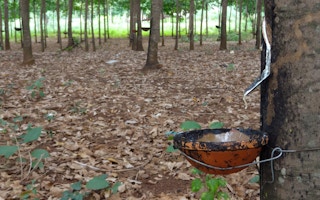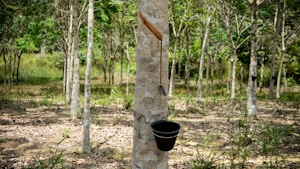Bouncy, elastic, compressible and moldable—the unique properties of natural rubber make it one of the most widely used materials, found in products from pencil erasers and birthday balloons to condoms and protective gloves.
Today nearly 50 per cent of every auto tire and 100 per cent of all aircraft tires are made of natural rubber. Even the invention of synthetic rubber and rubber-like plastics has not stunted demand for this natural material made from a milky sap known as latex, harvested from a tree native to the Amazon region, the Brazilian rubber tree (Hevea brasiliensis). In the last two decades, demand for natural rubber, 85 per cent of which is grown in Southeast Asia, has been increasing at a rate of 5 per cent a year.
However, over the centuries since rubber plantations took root, life has not become much better for smallholder farmers, who produce more than 80 per cent of the crop worldwide. In Thailand, the world’s biggest rubber exporter, the country’s 2 million rubber farmers, many of them migrant labour from poorer neighbouring countries, earn as little as 200 baht (US$6) a day, and the use of methamphetamine is common as workers are pressured to harvest at ever faster speeds.
Meanwhile tropical forests are being lost at an alarming rate as they are cleared to make way for rubber plantations, threatening biodiversity in the world’s most species-rich regions. “As global demand for rubber products shows no sign of slowing, models of ‘business as usual’ scenarios have predicted major habitat conversion to rubber plantations at a possible further five million hectares globally by 2024,” says Vina Dharmarajah, Asia director of Birdlife International.
As consumers and the companies that buy rubber grow more discerning about rubber’s environmental and social impacts, so the pressure builds on the industry to produce sustainable natural rubber (SNR), grown in a way that protects forests while meeting rising demand for the commodity.
Eco-Business looks at how rubber can be grown sustainably, who’s buying SNR, and how to build the movement for sustainable rubber cultivation.
1. The impact of rubber farming in Southeast Asia
Farming rubber sustainably is complex and expensive, and requires an overhaul of traditional farming practices.
Deforestation has historically been driven by high rubber prices, which is why it is critical that farmers increase yield to ensure that, when prices rise again, increased rubber production does not come at a cost for forests.
Unsustainably-managed rubber plantations can create severe air pollution if, to clear land quickly and cheaply, it is slashed and burned, which has a major impact on forest flora and fauna.
Due to the heavy use of herbicides to clear the land to manage the risk of snake bites, animal species that depend on the destroyed plants quickly succumb too. Furthermore, rain erodes the exposed earth, deteriorating the soil quality and exacerbating crop growth problems.
Rubber trees are susceptible to blight. Scientists have cautioned that a single spore of South American leaf blight reaching Southeast Asia could wipe out a substantial portion of the industry.
2. How can rubber be grown sustainably?
The process for cultivating natural rubber sustainability involves a few key steps, from land preparation to planting and harvesting.
To avoid the negative effects of expanding rubber plantations, land use planning should be based on a solid understanding of rubber farming constraints and their ecological impacts. Local governments and research institutes can use remote sensing studies as a reference point to promote sustainable rubber cultivation.
Before establishing a plantation, growers need to obtain land use permission from indigenous communities who live on or near the land, a process the United Nations Permanent Forum on Indigenous Issues defines as free, prior and informed consent (FPIC).
It takes about seven years for a rubber tree to mature before it can produce rubber for tapping, and how the crop is planted, harvested and cleared affects the sustainability of the plantation. For example, intercropping rubber with timber trees and medicinal plants counters the ill effects of monoculturing.
In October 2018, an independent platform for sustainable rubber cultivation, the Global Platform for Sustainable Natural Rubber (GPNSR), was set up with support from the World Business Council for Sustainable Development to improve the sustainability of the natural rubber value chain.
GPSNR director Stefano Savi, who joined the organisation six months ago from the palm oil industry’s lead certifier, Roundtable on Sustainable Palm Oil (RSPO), said: “We work with players in the natural rubber industry, as well as NGOs to help a move towards sustainably produced natural rubber. GPSNR will consider the people, communities and natural resources touched by natural rubber production, in a global and truly multi-stakeholder effort to drive improvements in the socio-economic and environmental performance of the natural rubber value chain.”
In a nutshell, sustainable rubber farming makes rubber cultivation profitable while minimising harm for people and the planet, and GPSNR aims to chart a course for the rubber industry that avoids the problems that have blighted the agricultural sector: deforestation, land grabbing and human rights violations.
3. What are the barriers to joining the sustainable natural rubber movement?
Many of the problems with growing a responsible natural rubber sector come from the higher initial cost of growing rubber trees sustainably. It costs more to pay fair wages that buffer farmers from market uncertainties. But over the long term, higher pay ensures that farmers do not switch to other crops such as palm oil, or resort to unsustainable agricultural farming methods that lead to lower yield and greater environmental impact.
Currently, rubber supply is higher than demand, which gives buyers the upper hand—including tire companies that want to reduce their environmental footprints. Some of the founding members of the GPSNR, including German carmaker BMW and tire manufacturer Bridgestone, are already leading industry-wide efforts to kick-start the SNR movement.
4. Where can I find sustainable rubber products?
The low market prices paid to rubber tappers, plantation workers and smallholder farmers make it difficult for them to support themselves and their families. By supporting ethical procurement suppliers, companies may be paying a premium, but will help ensure the long-term sustainability in rubber supply and market stability. An early way to address the problem came through associations such as the Fair Rubber Association and World Wide Fund for Nature, which advocated for sustainable rubber production. GPSNR has emerged out of a desire from multiple stakeholders to define and implement a sustainable natural rubber system.
5. Who’s using sustainable rubber?
By joining GPSNR, which is working on standards to protect biodiversity and water resources, improve yields, and increase supply chain transparency and traceability, rubber-buying businesses can get access to a broad network of resources and contacts for practical sustainability solutions for their supply chains.
Some companies have already started on their journey towards sustainable rubber. GPSNR member rubber producers have committed to sustainable production, and a number of buyers have made ambitious pledges to source sustainable rubber. In 2017, General Motors became the first car firm to commit to responsible rubber sourcing. BMW and Toyota have since done the same.
Tire manufacturer Michelin—the world’s largest buyer of natural rubber—was the first tire maker to commit to responsible rubber sourcing in 2016. Competitors Pirelli, Goodyear, Sumitomo, Continental, Yokohama, Hankook, Toyo Tires and Bridgestone have since followed.
Bridgestone Americas’ senior counsel, environmental, health safety and sustainability, Andy Thompson, says his company has worked hard over the last year to understand how its suppliers are living up to sustainability standards. “Sustainable natural rubber across the value chain will come through collaboration with responsible partners within the value chain and civil society,” he says.














